The Samsung 960 EVO (1TB) Review
by Billy Tallis on November 15, 2016 10:00 AM ESTMixed Random Read/Write Performance
The mixed random I/O benchmark starts with a pure read test and gradually increases the proportion of writes, finishing with pure writes. The queue depth is 3 for the entire test and each subtest lasts for 3 minutes, for a total test duration of 18 minutes. As with the pure random write test, this test is restricted to a 16GB span of the drive, which is empty save for the 16GB test file.
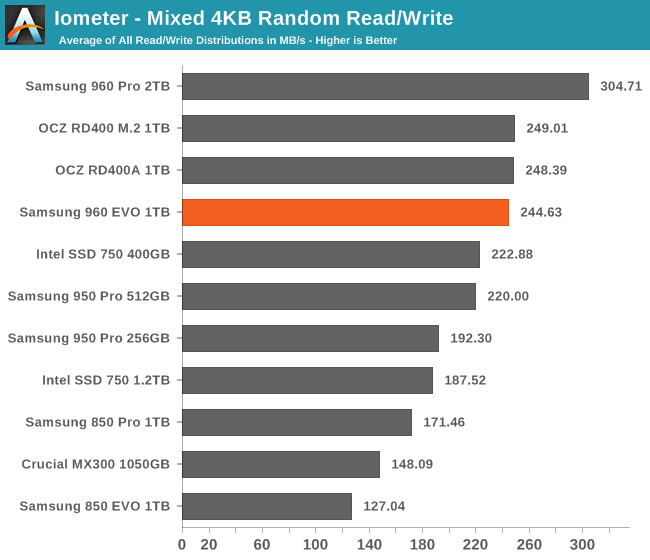
The 960 EVO is essentially tied for second place with the OCZ RD400 and significantly behind the 960 Pro in overall performance on mixed random I/O.
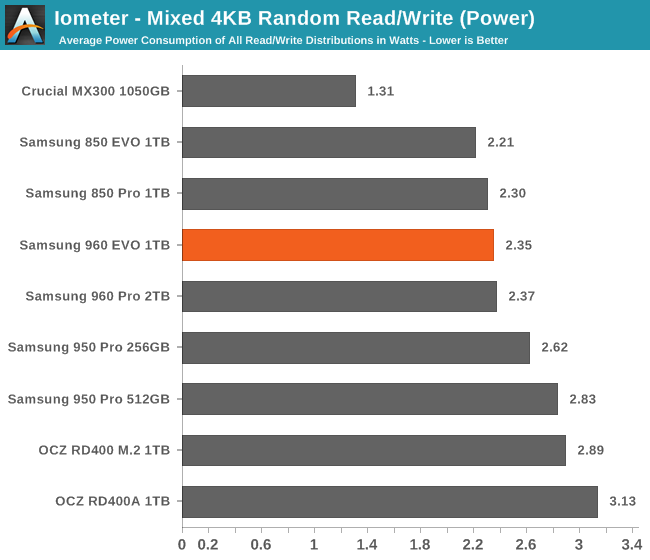
The 960 EVO's power efficiency on this test is not great, but it is a big improvement over last year's 950 Pro.
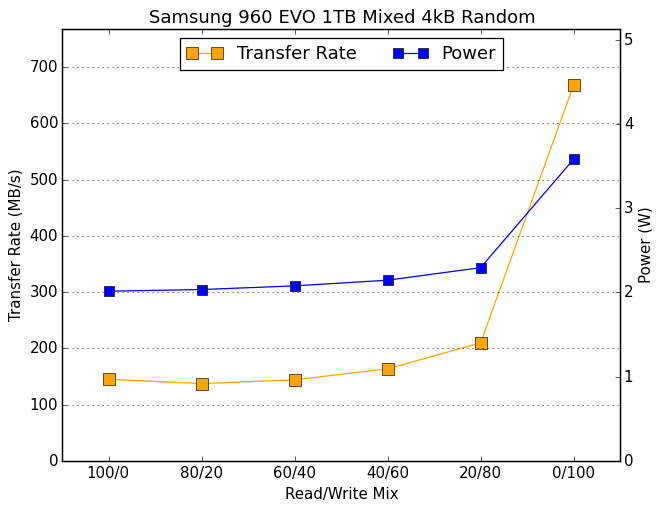 |
|||||||||
The 960 EVO's high performance score comes primarily from its great performance in the pure write final phase of the test. Throughout the rest of the test, the 960 EVO is not as fast as the 950 Pro.
Mixed Sequential Read/Write Performance
The mixed sequential access test covers the entire span of the drive and uses a queue depth of one. It starts with a pure read test and gradually increases the proportion of writes, finishing with pure writes. Each subtest lasts for 3 minutes, for a total test duration of 18 minutes. The drive is filled before the test starts.
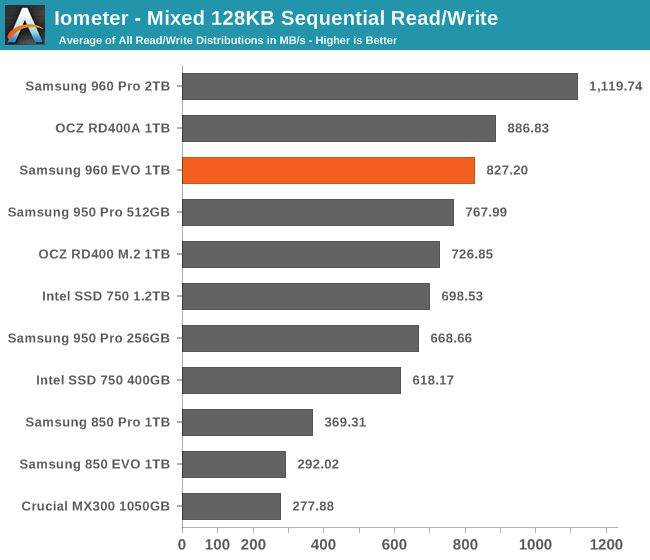
The 960 EVO's mixed sequential I/O performance is the second-fastest among M.2 SSDs and third place overall. Performance is modestly improved over the 950 Pro.
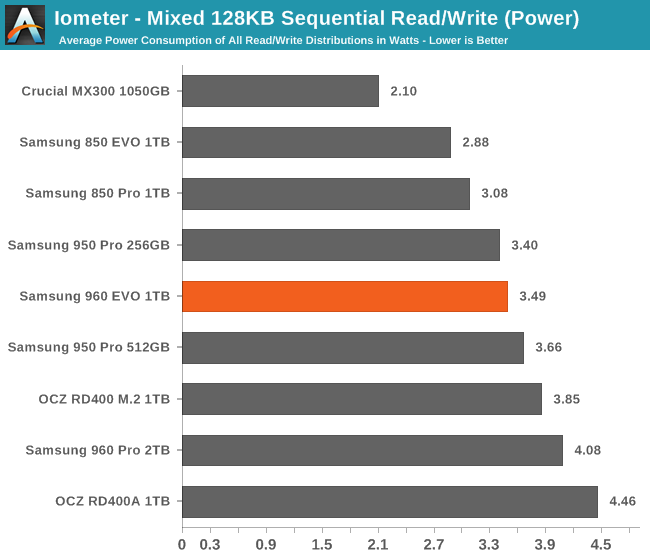
The 960 EVO's power efficiency is better than most PCIe SSDs, but still well behind the 960 Pro.
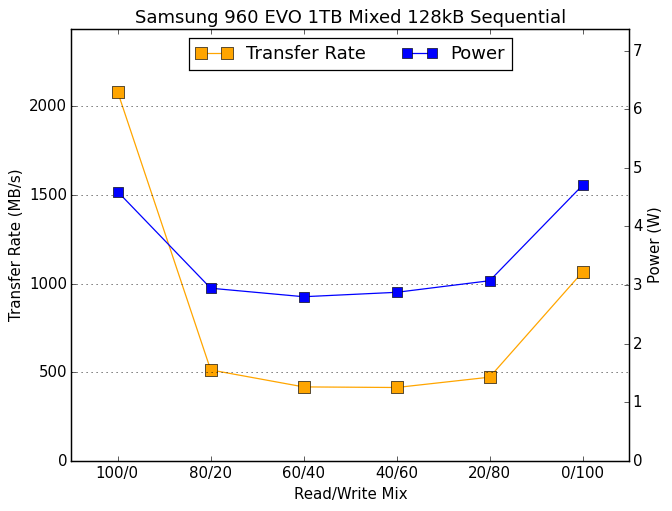 |
|||||||||
The 960 EVO's performance in the pure read first phase of the test is great, but its performance with an 80/20 mix is much worse than the 950 Pro or OCZ RD400. The worst-case performance is also not as good as the RD400 or 960 Pro.










87 Comments
View All Comments
DanNeely - Tuesday, November 15, 2016 - link
The Intel 750 doesn't have power data in Bench. My guess would be that the current power benchmarks post-date when the review sample was returned.Sometimes there are oversights, but most of the time when some devices are only shown in a subset of the charts its because data to score them on the others isn't available. Most often due to moving testsuite targets or breaking changes in the benchmark applications.
http://www.anandtech.com/bench/SSD15/1440
http://www.anandtech.com/bench/product/1458
Billy Tallis - Tuesday, November 15, 2016 - link
Yeah, the Intel 750 was tested by Kristian before we had working PCIe power measurement. It also complicates things by using both the 12V and 3.3V rails, when I only have one meter. Adding power consumption data isn't a high priority for me, because the Intel 750 is always in last place, by a lot: its idle power is higher than the load power of most M.2 drives on many of the tests. The Intel 750 would distort the scale of the power graphs to the point that it would be hard to see the differences between the M.2 drives.willis936 - Tuesday, November 15, 2016 - link
How are M.2 drives mounted during these reviews? Do you use the motherboard's M.2 connector? A PCIe adapter without a heatsink? A PCIe adapter with a heatsink?Billy Tallis - Tuesday, November 15, 2016 - link
Unless otherwise specified, M.2 PCIe drives are tested in a simple Lycom DT-120 adapter, which is connected to the riser card used for power measurement, which is in turn connected to the primary PCIe 3.0 x16 slot. Drives like the OCZ RD400A and Plextor M8PeY are also tested in their bundled adapter cards with whatever heatsink that provides, and any other M.2+heatsink results I report are using the Angelbird Wings PX1 adapter and heatsink.R3MF - Tuesday, November 15, 2016 - link
Is that v2.0 driver available on day one?(for Windows7 users wanting to do a fresh install)
CrazyElf - Tuesday, November 15, 2016 - link
First, it is the drive that will likely play a role in making M.2 SSDs a much more popular form factor, perhaps to the point where NVMe drives overtake SATA. Most people do not need the write endurance that the MLC SSDs have.Second, the performance is quite good, and although there is still a huge price premium over SATA SSDs, the massive performance increase is much more justifiable in terms of cost premium compared to say, the 960 Pro, which is for people who want the best. It will remain that way, until the 970 Pro and Evo come out, or perhaps until a 3D XPoint SSD comes out.
Third, I expect an enterprise version to come out too, with power loss protection. The only real issue i see is if there is something like the 840 Evo that caused performance drops, but so far Samsung's TLC drives since then have been solid.
TheinsanegamerN - Tuesday, November 15, 2016 - link
I believe the 840 evo was planar NAND, whereas the newer designs are 3D NAND. That may be part of the reason.XabanakFanatik - Tuesday, November 15, 2016 - link
I see no mention of Samsung's silent delays of these drives. As of now most models of both the pro and evo are listed as ship by late December or January.Kind of disappointing you would gloss over a 2-3 month delay like that.
haukionkannel - Tuesday, November 15, 2016 - link
It seems that Samsung was lucky that their 250GB unit did fail...http://www.tomshardware.com/reviews/samsung-960-ev...
It seems to completely another series than 1Tb version.
TheinsanegamerN - Tuesday, November 15, 2016 - link
What are you trying to say here?